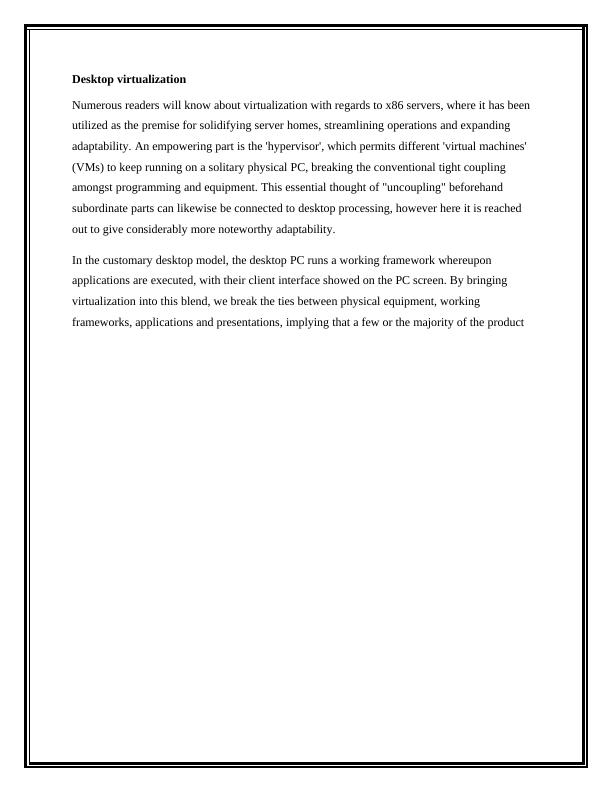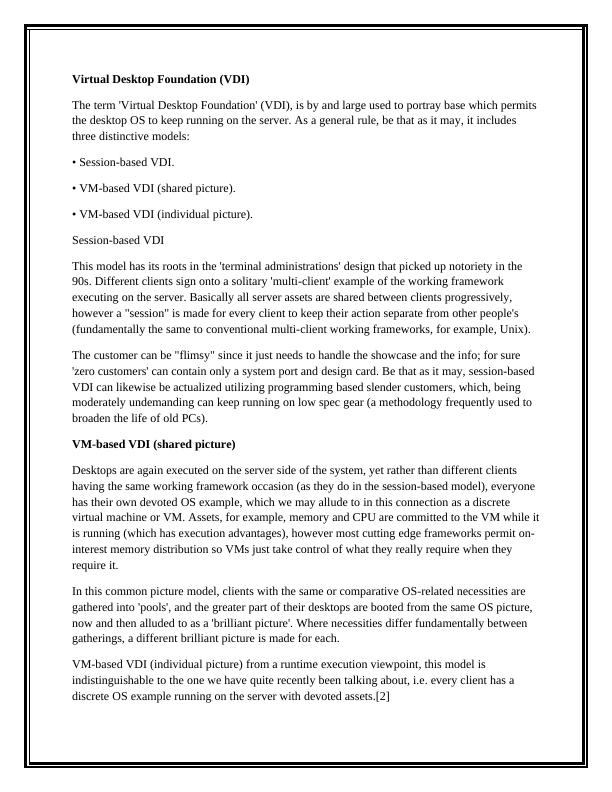Ask a question from expert
Desktop Virtualization- Doc
16 Pages5077 Words233 Views
Added on 2020-01-16
Desktop Virtualization- Doc
Added on 2020-01-16
BookmarkShareRelated Documents
Desktop virtualization Numerous readers will know about virtualization with regards to x86 servers, where it has been utilized as the premise for solidifying server homes, streamlining operations and expanding adaptability. An empowering part is the 'hypervisor', which permits different 'virtual machines' (VMs) to keep running on a solitary physical PC, breaking the conventional tight coupling amongst programming and equipment. This essential thought of "uncoupling" beforehand subordinate parts can likewise be connected to desktop processing, however here it is reached out to give considerably more noteworthy adaptability. In the customary desktop model, the desktop PC runs a working framework whereupon applications are executed, with their client interface showed on the PC screen. By bringing virtualization into this blend, we break the ties between physical equipment, working frameworks, applications and presentations, implying that a few or the majority of the product

segments can be run or oversaw from a remote server rather than locally (Figure 1):As appeared in this realistic, notwithstanding having a decision about where the working framework and individual applications dwell, we can likewise pick whether client data, for example, application information and design settings are put away locally or on the server. The most recent era of desktop virtualization arrangements permits these choices (and that's only the tip of the iceberg) to be unreservedly blended and coordinated, by going ahead at a specific minute in time. The way the working framework and applications are served up to a client might be distinctive, for instance, contingent upon whether they are signing in from their work area PC over the corporate system, from their portable workstation over an inn WiFi administration, or from their home PC over a household broadband association.[1]

Virtual Desktop Foundation (VDI) The term 'Virtual Desktop Foundation' (VDI), is by and large used to portray base which permits the desktop OS to keep running on the server. As a general rule, be that as it may, it includes three distinctive models: • Session-based VDI. • VM-based VDI (shared picture). • VM-based VDI (individual picture). Session-based VDI This model has its roots in the 'terminal administrations' design that picked up notoriety in the 90s. Different clients sign onto a solitary 'multi-client' example of the working framework executing on the server. Basically all server assets are shared between clients progressively, however a "session" is made for every client to keep their action separate from other people's (fundamentally the same to conventional multi-client working frameworks, for example, Unix). The customer can be "flimsy" since it just needs to handle the showcase and the info; for sure 'zero customers' can contain only a system port and design card. Be that as it may, session-based VDI can likewise be actualized utilizing programming based slender customers, which, being moderately undemanding can keep running on low spec gear (a methodology frequently used to broaden the life of old PCs). VM-based VDI (shared picture) Desktops are again executed on the server side of the system, yet rather than different clients having the same working framework occasion (as they do in the session-based model), everyone has their own devoted OS example, which we may allude to in this connection as a discrete virtual machine or VM. Assets, for example, memory and CPU are committed to the VM while itis running (which has execution advantages), however most cutting edge frameworks permit on-interest memory distribution so VMs just take control of what they really require when they require it. In this common picture model, clients with the same or comparative OS-related necessities are gathered into 'pools', and the greater part of their desktops are booted from the same OS picture, now and then alluded to as a 'brilliant picture'. Where necessities differ fundamentally between gatherings, a different brilliant picture is made for each. VM-based VDI (individual picture) from a runtime execution viewpoint, this model is indistinguishable to the one we have quite recently been talking about, i.e. every client has a discrete OS example running on the server with devoted assets.[2]

The distinction, nonetheless, is that each client's desktop is booted from a different OS picture. This gives more client adaptability as every desktop can be extraordinarily set up and even custom-made by the client (subject to strategy). Be that as it may, with every client's picture being put away independently on circle, significantly more stockpiling is required to actualize this model, and administration overhead is liable to be higher. Corner OS organization models Notwithstanding VDI, there are two different OS organization models you may go over, howeverboth of these are focused at specialty regions as opposed to ordinarily happening standard situations. Desktop on a cutting edge It is conceivable to execute a VDI-like model utilizing committed equipment, with every client's OS example running on a different devoted 'server sharp edge' with its own CPU and memory. As shared asset VDI arrangements have turned out to be more proficient, adaptable and performing, be that as it may, the moderately costly 'desktop on a sharp edge' elective has gotten to be connected with a little number of extremely uncommon situations, so we won't talk about itfurther. Customer facilitated virtual machine In this model numerous VMs are keep running on a solitaryphysical desktop (as opposed to on the server). It is generally utilized by IT experts to make numerous OS establishments so that diverse improvement, testing and investigating exercises can be completed on the same machine. This has evident efficiency advantages and in addition boosting rate of profitability in high spec gear. The model is regularly additionally utilized by Apple Macintosh clients to run Windows as a visitor OS with a specific end goal to get to corporate applications.[3] Synopsis of application organization models The two things that matter the most are the place the application executes and where it searches for the particular settings and different assets (e.g. shared libraries) that it needs (Table 1):

End of preview
Want to access all the pages? Upload your documents or become a member.
Related Documents
Running Windows XP - (Doc)lg...
|25
|5916
|39
The report on operating systemlg...
|29
|4801
|13
Critical Evaluation of FortiSIEM Security Toollg...
|17
|3517
|226
Business Process Modelling for Second Hand Book Buying and Sellinglg...
|8
|1896
|344
Electronic and Systems Engineeringlg...
|12
|1621
|19
WebGL Report on WebGL 2019-20 Module: Third Measurelg...
|10
|2282
|310